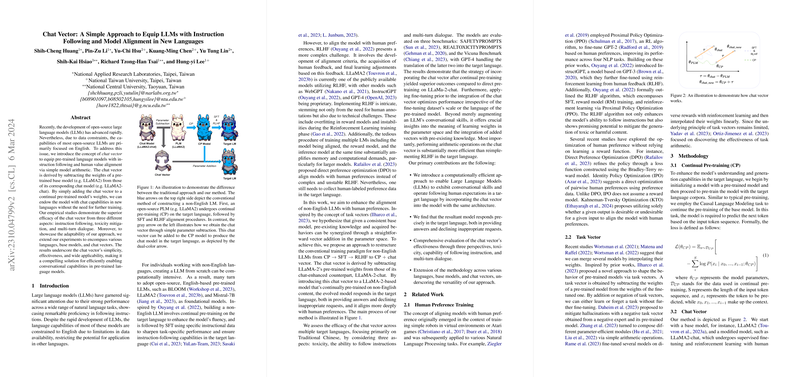An Analysis of "Chat Vector: A Simple Approach to Equip LLMs with Instruction Following and Model Alignment in New Languages"
The paper entitled "Chat Vector: A Simple Approach to Equip LLMs with Instruction Following and Model Alignment in New Languages" presents a novel methodology for adapting LLMs to new linguistic contexts with efficiency and precision. The authors introduce the concept of a "chat vector," derived from the arithmetic operation of subtracting the weights of a pre-trained model from those of its chat-enhanced version. This approach promises to equip LLMs with instruction-following capabilities and alignment with human preferences across varied languages without extensive retraining.
Key Contributions
The primary contribution of this work lies in the introduction and implementation of the chat vector framework. By applying a chat vector to a continually pre-trained model's weights, the paper reveals notable enhancement in instruction adherence, toxicity mitigation, and handling multi-turn dialogue in non-English languages. This is evidenced by evaluations conducted across several benchmarks, such as the Vicuna Benchmark, SAFETYPROMPTS, and REALTOXICITYPROMPTS, with translations facilitated by GPT-4 where necessary. These evaluations demonstrate the effectiveness of integrating chat vectors into LLMs trained for new linguistic contexts, marking a significant step forward in the efficient adaptation of LLMs across languages.
Numerical Results and Contradictory Claims
The empirical results are significant, showing superior performance through the chat vector approach compared to traditional methods such as continual pre-training followed by supervised fine-tuning (SFT) and reinforcement learning with human feedback (RLHF). Notably, the paper presents a bold claim that the integration of chat vectors, coupled with continual pre-training, is computationally more efficient than reimplementing RLHF for target languages. This bold assertion challenges the conventional reliance on RLHF, highlighting potential efficiencies in computational resources and memory when leveraging arithmetic operations on model weights.
Implications and Future Developments
The implications of this research are profound, both theoretically and practically. Theoretically, it deepens our understanding of the structure of learning weights within the parameter space of LLMs, potentially leading to more refined models with enhanced transfer learning capabilities. Practically, the chat vector approach provides a viable and efficient pathway for the deployment of LLMs in multilingual contexts, benefiting from reduced computational overheads and the effective alignment of models with human conversational norms without the need for extensive additional training.
Speculating on future developments in AI, this framework could stimulate a new wave of research focused on parameter-efficient adaptation strategies, particularly for languages with limited annotated resources. The findings also invite future exploration into the optimization of chat vector magnitude and the careful tuning of these vectors across different linguistic domains and tasks.
Conclusion
In sum, the "Chat Vector" paper presents a methodologically sound and computationally efficient approach to equipping LLMs with valuable conversational capabilities in new languages. By harnessing the power of simple model arithmetic, this research potentially alters the landscape of multilingual LLM deployment, offering a sophisticated yet straightforward tool for aligning models with nuanced linguistic and cultural dynamics. This paper could act as a catalyst for broader explorations into the integration of human preference alignment in machine learning models, ultimately driving advancements in the field of natural language processing.
